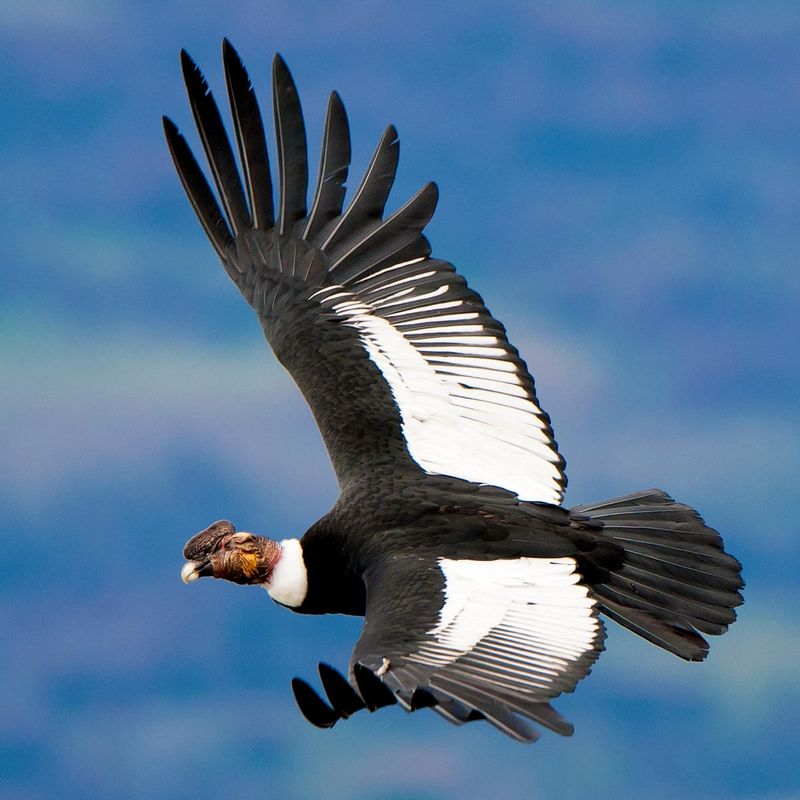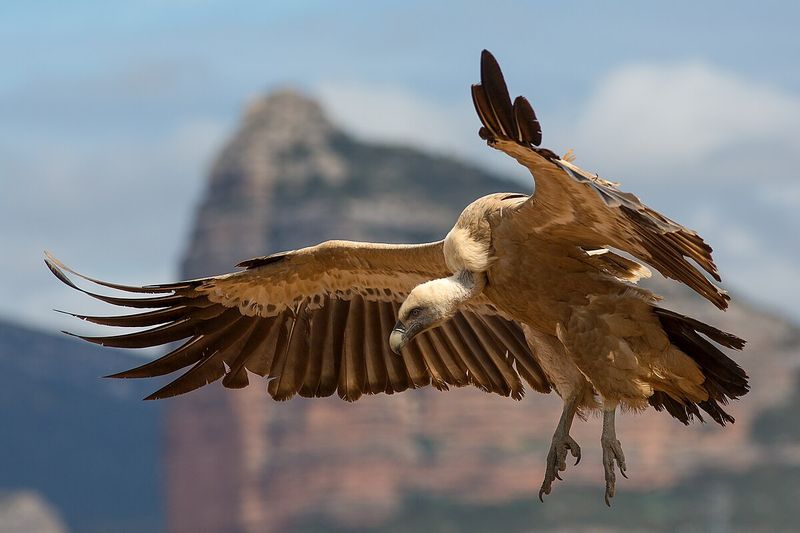📖 Table of Content:
In the vast skies that dominate our planet, there are some birds whose sheer size leaves us in awe. From the albatrosses that glide effortlessly over the oceans to the condors soaring above mountain ranges, these magnificent creatures are not only marvels of nature but also vital parts of their ecosystems.
This blog post delves into the fascinating world of the largest flying birds, celebrating their unique characteristics, habitats, and roles in the natural world.
Join us on this journey to discover ten of the largest flying birds that capture our imagination with their majestic presence.
1. Wandering Albatross
The Wandering Albatross is a remarkable bird, known for its impressive wingspan that can exceed 11 feet, making it the largest of any living bird. This majestic seabird spends most of its life soaring over the open oceans, particularly in the Southern Hemisphere.
Its ability to glide for hours without flapping its wings is a testament to its evolutionary perfection.
With an elegant white and black plumage, the Wandering Albatross is a sight to behold against the vast oceanic backdrop. It feeds primarily on squid and fish, often following ships to scavenge for food. Their courtship dance is a fascinating ritual involving synchronized movements and harmonious calls.
These birds are under threat due to longline fishing and environmental changes, which impact their food supply. Conservation efforts are crucial to preserving their population and ensuring that future generations can witness their graceful presence.
2. Andean Condor
The Andean Condor is an iconic symbol of the Andes, known for its incredible wingspan of nearly 10 feet. As one of the world’s largest flying birds, it plays a vital role in the ecosystem as a scavenger, cleaning up carrion and preventing the spread of disease.
Its striking black plumage with a distinctive white ruff around its neck makes it unmistakable.
These birds inhabit the mountainous regions of South America, where they glide effortlessly on thermal updrafts. Their ability to soar for hours without flapping is mesmerizing, showcasing their mastery of the skies. Andean Condors are social creatures, often seen congregating in large groups around abundant food sources.
Despite their majesty, they face threats from habitat loss and hunting. Conservation initiatives aim to protect these magnificent birds and their habitats, ensuring they continue to be a part of the Andean landscape for generations to come.
3. Dalmatian Pelican
One of the heaviest flying birds, the Dalmatian Pelican boasts a wingspan that can exceed 9 feet.
This impressive bird is known for its distinctive curly nape feathers and large bill, which it uses effectively to scoop up fish in shallow waters. Its silvery-white plumage glistens under the sun, making it a splendid sight.
Dalmatian Pelicans are commonly found in wetlands and freshwater lakes across Europe and Asia. They are social birds, often seen flying in flocks or nesting in colonies. Their graceful flight and synchronized movements are a testament to their adaptability and intelligence.
However, these pelicans face challenges from habitat destruction and pollution. Conservation efforts focus on protecting their natural habitats and ensuring the cleanliness of water bodies, vital for their survival. Witnessing a Dalmatian Pelican in flight is truly an awe-inspiring experience.
4. Great White Pelican
Renowned for its expansive wingspan of over 9 feet, the Great White Pelican is a magnificent bird. Often seen soaring over the freshwater lakes and rivers of Africa, it dazzles observers with its elegant flight.
The Great White Pelican’s white plumage, contrasted with pinkish skin and a striking yellow-orange bill, makes it a captivating presence in the sky.
These pelicans are social creatures, forming large flocks as they forage for fish, their primary diet. They work collaboratively, often engaging in cooperative fishing to corral fish into shallow waters for easier capture. Their synchronized swimming techniques are quite a spectacle to witness.
Despite their abundance, Great White Pelicans face threats from habitat destruction and water pollution. Conservation efforts aim to protect their habitats and ensure the sustainability of their food sources, allowing these magnificent birds to continue gracing the skies with their beauty.
5. Lappet-faced Vulture
The Lappet-faced Vulture, with its extensive wingspan and powerful build, is one of the largest vultures in Africa.
Known for its distinctive bare head and large folds of skin, or lappets, this vulture has adapted perfectly to a life of scavenging. It plays a crucial ecological role by consuming carrion, thus keeping the environment clean and disease-free.
Typically found in savannahs, deserts, and open mountain slopes, the Lappet-faced Vulture is a solitary bird except during feeding or nesting. Its flight is both powerful and graceful, marked by slow wing beats and soaring glides that allow it to cover great distances in search of food.
These vultures face significant threats from poisoning and habitat loss. Conservation initiatives are in place to protect these essential birds, focusing on reducing human-wildlife conflict and securing their habitats. Their presence is vital for the health of ecosystems they inhabit.
6. Marabou Stork
Often seen soaring over the African savannah, the Marabou Stork is known for its large stature and impressive wingspan of nearly 10 feet. This stork features a unique appearance, characterized by a bald head, thin legs, and a large, inflatable throat pouch that aids in thermoregulation.
Marabou Storks are opportunistic feeders, consuming a wide range of food, from carrion to live prey such as fish and small mammals. They play a vital role in the ecosystem by cleaning up carcasses and waste, thus preventing disease spread.
Despite their somewhat ungainly appearance, Marabou Storks are graceful fliers, utilizing thermal currents to travel long distances. However, they face threats from habitat destruction and pollution.
Conservation efforts focus on protecting their natural habitats and maintaining the ecological balance in areas where they live.
7. Kori Bustard
The Kori Bustard is the heaviest flying bird native to Africa, known for its impressive size and elaborate courtship displays. With a wingspan reaching up to 9 feet, this bird is a true spectacle on the African savannah.
The Kori Bustard is primarily terrestrial, preferring to walk rather than fly. Its diet consists of insects, small mammals, and seeds, which it forages in the grasslands. During mating season, males engage in dramatic displays to attract females, puffing up their throats and emitting deep booming calls.
These birds face threats from hunting and habitat loss. Conservation efforts are focused on protecting their habitats and raising awareness about their ecological importance. Observing a Kori Bustard in its natural setting is a rewarding experience, offering insight into the diverse wildlife of Africa.
8. Cinereous Vulture
As one of the world’s heaviest and largest raptors, the Cinereous Vulture, also known as the Eurasian Black Vulture, commands the skies over Europe and Asia with a remarkable wingspan that reaches nearly 10 feet.
Its dark plumage and robust build make it a striking figure in the air. As a scavenger, the Cinereous Vulture plays a critical role in its ecosystem by consuming dead animals and helping to prevent the spread of disease. These vultures are known for their solitary nature, often seen alone or in pairs.
Despite their critical ecological role, Cinereous Vultures face significant threats from habitat destruction and poisoning. Their presence is essential for maintaining the health of the ecosystems they inhabit.
9. California Condor
The California Condor is a symbol of successful conservation efforts, once teetering on the brink of extinction. With a wingspan of up to 9.5 feet, this majestic bird is one of North America’s largest flying birds.
California Condors are known for their black plumage, contrasting with a striking bald head that ranges in color from red to orange. These scavengers play a crucial role in their ecosystem, feeding on carrion and preventing the spread of disease. They are often seen soaring over the cliffs and canyons of the American West.
Thanks to intensive conservation programs, their population has been recovering, though they still face threats from habitat destruction and lead poisoning. Continued efforts are essential to ensure their survival.
Observing a California Condor in the wild is a testament to human dedication to preserving endangered species.
10. Eurasian Griffon Vulture
With an impressive wingspan of up to 9 feet, the Eurasian Griffon Vulture plays a crucial role in maintaining ecological balance. Commonly seen soaring over the rugged mountains and highlands of Europe, these vultures glide effortlessly on air currents.
Their pale brown plumage and distinctive hooked beak make them easily recognizable. As scavengers, Eurasian Griffon Vultures help to clean up carrion, thus preventing the spread of disease. They often congregate in large groups around abundant food sources, showcasing their social nature.
Witnessing a Eurasian Griffon Vulture in flight is truly a remarkable sight, highlighting the beauty and complexity of nature’s aerial giants.










